おすすめの製品
品質水準
使用法
kit sufficient for 1000 reactions (using 96 multiwell plates)
kit sufficient for 50 reactions (in a 2 mL cuvette)
包装
pkg of 1 kit
保管条件
dry at room temperature
テクニック
flow cytometry: suitable
protein staining: suitable
蛍光検出
λex 490 nm; λem 590 nm (JC-1 dye)
アプリケーション
cell analysis
detection
検出方法
fluorometric
輸送温度
dry ice
保管温度
−20°C
アプリケーション
特徴および利点
- 分離したミトコンドリアの染色、およびミトコンドリアの完全性を評価するための迅速かつ簡便な方法です。
- ミトコンドリア内膜の電気化学的ポテンシャル変化の検出に必要な全ての試薬が入っています。
- ミトコンドリア膜を透過性にすることにより、ミトコンドリアの電気化学ポテンシャルを消散させる抗生物質であるバリノマイシンを含有しています。バリノマイシンはJC-1の凝集を防ぐコントロ-ル試薬として用いることができます。
原理
アナリシスノート
キットの構成要素のみ
- DMSO 1 mL
- JC-1 Assay Buffer 5X 25 mL
- JC-1 Stain 25 μg
- Valinomycin Ready Made 100 μL
シグナルワード
Danger
危険有害性情報
危険有害性の分類
Acute Tox. 1 Dermal - Acute Tox. 1 Oral
保管分類コード
6.1A - Combustible acute toxic Cat. 1 and 2 / very toxic hazardous materials
引火点(°F)
Not applicable
引火点(℃)
Not applicable
適用法令
試験研究用途を考慮した関連法令を主に挙げております。化学物質以外については、一部の情報のみ提供しています。 製品を安全かつ合法的に使用することは、使用者の義務です。最新情報により修正される場合があります。WEBの反映には時間を要することがあるため、適宜SDSをご参照ください。
毒物及び劇物取締法
キットコンポーネントの情報を参照してください
PRTR
キットコンポーネントの情報を参照してください
消防法
キットコンポーネントの情報を参照してください
労働安全衛生法名称等を表示すべき危険物及び有害物
キットコンポーネントの情報を参照してください
労働安全衛生法名称等を通知すべき危険物及び有害物
キットコンポーネントの情報を参照してください
カルタヘナ法
キットコンポーネントの情報を参照してください
Jan Code
キットコンポーネントの情報を参照してください
試験成績書(COA)
製品のロット番号・バッチ番号を入力して、試験成績書(COA) を検索できます。ロット番号・バッチ番号は、製品ラベルに「Lot」または「Batch」に続いて記載されています。
この製品を見ている人はこちらもチェック
資料
Cellular apoptosis assays to detect programmed cell death using Annexin V, Caspase and TUNEL DNA fragmentation assays.
Oxidative stress is mediated, in part, by reactive oxygen species produced by multiple cellular processes and controlled by cellular antioxidant mechanisms such as enzymatic scavengers or antioxidant modulators. Free radicals, such as reactive oxygen species, cause cellular damage via cellular.
Oxidative stress is mediated, in part, by reactive oxygen species produced by multiple cellular processes and controlled by cellular antioxidant mechanisms such as enzymatic scavengers or antioxidant modulators. Free radicals, such as reactive oxygen species, cause cellular damage via cellular.
ライフサイエンス、有機合成、材料科学、クロマトグラフィー、分析など、あらゆる分野の研究に経験のあるメンバーがおります。.
製品に関するお問い合わせはこちら(テクニカルサービス)










